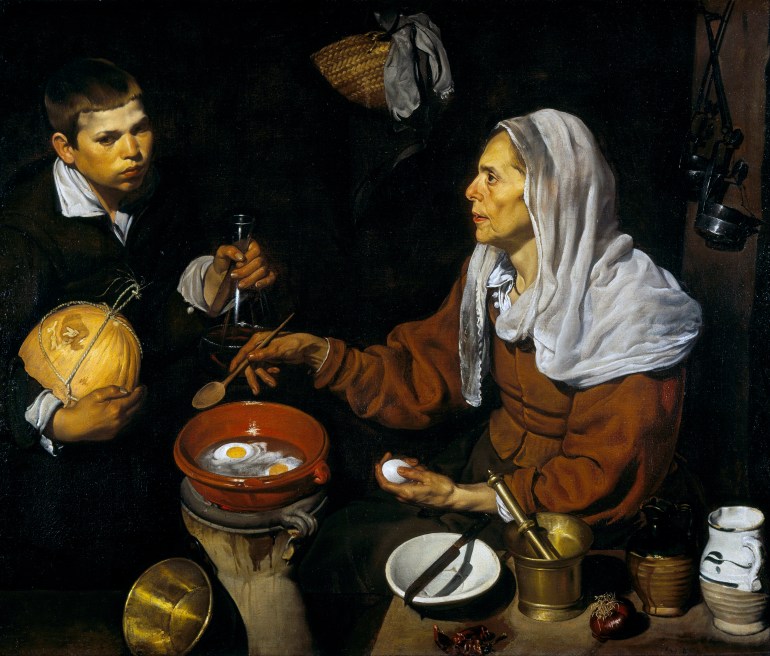Food occupied a good area for the production of plastic arts since the Greeks and Romans held their banquets and feasts to celebrate victory in wars.
Renaissance painters provided oil paintings and murals filled with food, drink, animals, and tableware. Meticulous painting of food was a way for painters to demonstrate their artistic skills throughout all those centuries, and this tendency remained a constant feature of painting throughout the history of Western art until modern times.
The classical historian Pliny claimed that the Greek painter Zeuxis painted grapes so realistic that birds came to pick them.
Food also appeared in the Baroque period of Spanish painters, such as Diego Velázquez and Francisco de Zurbarán, with an aura of holiness as a blessing bestowed by God on man.
And if we reach the twentieth century, food was central to popular paintings due to the consumerism that dominated the art space.
Last Supper
In his famous painting “The Last Supper,” the Flemish painter Merten de Vos (1523-1603) presented Jesus, peace be upon him, sitting in the middle of the dining table with his disciples lined up around him.
Today, the “Last Supper” is one of the most famous themes that inspired painters throughout history, and it is also the most famous dinner in the history of banquets and foods that has ever been painted, and this dinner, despite its great fame, is not rich in food or drink;
It appears on the table subsistence bread distributed among the "disciples" only.
Grandma's recipes
In his painting "Breakfasts", Dutch painter Floris van Dyck (1575-1651) introduced the classic ingredients of the ancestral breakfast in the Netherlands.
This classic Dutch breakfast of cheese, bread, nuts and fruit, for its richness in dietary minerals, is served on a fine white linen napkin to protect the red tablecloth, the common color of bedspreads in 17th century Haarlem.
The painting belongs to the Baroque school, an era in which the arts flourished in Europe from the early 17th century until the 1840s. The Baroques followed Renaissance styles and combined them with neoclassical styles;
The paintings were rich in detail and dramatic in events and topics.
We also see in the painting of the Spanish painter Diego Velázquez (1599-1660) “An Old Lady Frying Eggs” one of the classic meals not only in Europe, but throughout the world throughout the ages.
Veláthquez was 18 or 19 years old when he painted this painting.
Spanish painter Diego Velázquez's painting "Old Lady Frying Eggs" (Wikimedia)
Veláthquez painted everyday people and objects straight from real life, and his fascination with contrasting materials and textures, and the reflection of shadow and light on opaque and reflective surfaces, enriched his artistic subjects.
We see the old woman in the painting looking at the grandson for whom the meal is likely being prepared, and Veláthquez shined light from left to right to illuminate the woman's face, pots, and eggs, so much so that he combined deep darkness and high contrast of light with the use of subtle color tones and a predominantly sepia palette.
Food and social life
The excessive interest on the part of the painters to record the types of food and meals from one era to another is not due to the interest in eating only as food for the body, but because the types of food themselves were used to denote the social class to which people belong;
Extremely poor families were photographed eating potatoes, which were used as animal food in the late 19th and early 20th centuries.
And the impressionist painter Vincent van Gogh presented in his painting "Eat Potatoes" one of those families, in 1885, who live a harsh life in the countryside, and their members gathered around the dinner table eating potatoes.
In one of his letters, he wrote that he had deliberately chosen crude and ugly models because he wanted a true reflection of the suffering of the rural poor.
"The Potato Eaters" by Vincent van Gogh (Wikimedia)
In a letter to his brother Theo, Van Gogh said, "I wanted to convey the idea that people who ate potatoes by the light of an oil lamp used the same hands with which they took food from the plate to work the earth;
In the European countryside, peasants lived a destitute life, and were often portrayed as good because of the Europeans' obsession with the ivory-white, slender body, but van Gogh saw them with their dull and sun-scorched skin;
They were like “the soil they are digging,” as he put it.
And his painting was about potatoes without bread because they are too poor to buy wheat for bread and replace it with potatoes.
"It's a true country painting," says Van Gogh, "but if people would rather see it covered in sugar (painters' obsession with the whiter body) let them do it. Personally, I think it's better to paint it trite as it is than to give it a non-existent charm."

